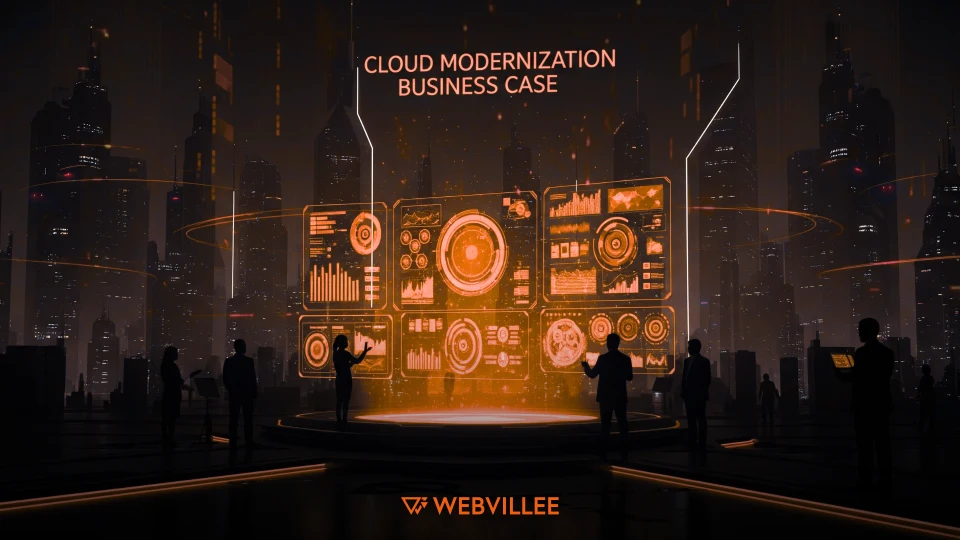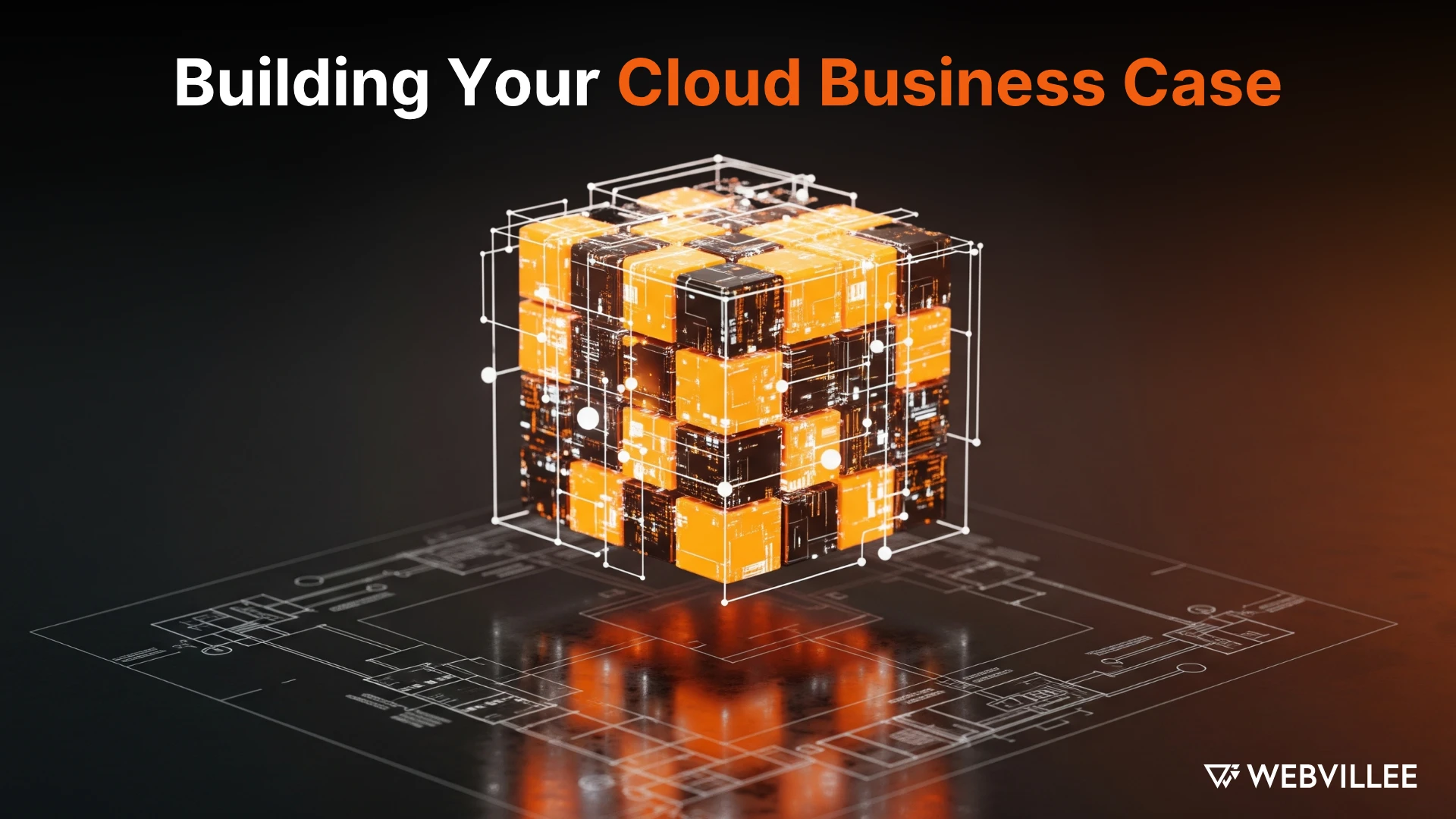Securing Executive Approval for Cloud Investment
A business case for cloud modernization requires quantified costs, measurable benefits, risk assessments, and clear strategic alignment to secure executive approval. Without this cloud migration justification, even technically sound proposals fail to gain funding.
Decision makers scrutinize technology investments more carefully now than in previous years. They demand specific financial returns, realistic timelines, and honest risk evaluation before committing budget to multi year initiatives.
This guide provides a framework for building compelling business cases that address executive concerns and demonstrate why cloud modernization deserves investment priority.
Why Does Cloud Modernization Need a Formal Business Case?
Executive approval requires demonstrating financial justification and business value beyond technical team preferences or industry trends. Leaders allocate capital based on expected returns, not technology enthusiasm.
Understanding why cloud modernization matters starts with stakeholder expectations. CFOs want ROI calculations and payback periods. CEOs care about competitive positioning and growth enablement. Board members focus on risk mitigation and strategic alignment.
Business justification requirements:
- Financial analysis showing costs versus benefits
- Risk assessment with mitigation strategies
- Strategic alignment with company objectives
- Implementation timeline with resource needs
- Success metrics for measuring outcomes
Budget scrutiny intensifies during economic uncertainty. Every dollar spent on cloud migration competes with other strategic initiatives. Your business case must prove cloud investment delivers better returns than alternative uses of capital.
Investment approval processes vary by organization size and governance structure. Smaller companies might require only executive team consensus. Enterprise organizations often need board approval for major technology investments. Understanding your approval chain helps you tailor the business case appropriately.
What Cost Components Should You Include?
Total cloud migration costs span upfront migration work, ongoing infrastructure expenses, training programs, and operational changes that continue for years. Accurate budget planning requires accounting for all cost categories, not just obvious licensing fees.
Migration expenses include assessment work, application refactoring, data transfer, testing, and cutover activities. These one time costs vary dramatically based on application complexity and current infrastructure state. Organizations typically underestimate migration effort by 30 to 50% without thorough assessment.
Complete cost breakdown:
- Migration services and consulting fees
- Application refactoring and modernization work
- Data migration and validation efforts
- Infrastructure costs during parallel operation
- Cloud platform fees and consumption charges
- Training and change management programs
- Ongoing support and optimization resources
Hidden costs emerge throughout implementation. Legacy application dependencies require more refactoring than expected. Data quality issues necessitate cleanup before migration. Staff require extensive training on cloud operations and architecture patterns.
The total cost of ownership extends beyond migration. Monthly cloud consumption, support contracts, monitoring tools, and dedicated cloud operations staff represent ongoing expenses. Cloud Solution implementations require careful cost modeling across 3 to 5 years to understand true financial impact.
Multi year projections account for consumption growth as usage scales. Cloud costs that seem reasonable initially can balloon as transaction volumes increase or new workloads deploy. Include growth assumptions in financial models to avoid budget surprises later.

How Do You Calculate Cloud Migration ROI?
Cloud migration ROI combines quantified cost savings, operational efficiency improvements, and revenue enablement that together justify the investment. Calculate return on investment by comparing total benefits against total costs over a defined period.
The basic ROI formula divides net benefits by total costs. If cloud modernization costs $2M and delivers $3M in cumulative benefits over three years, the ROI is 50%. However, this simple calculation masks important nuances around timing and benefit realization.
ROI calculation components:
- Infrastructure cost savings: Reduced data center, hardware, and maintenance expenses
- Operational efficiency: Reduced manual work through automation and self service
- Productivity gains: Faster deployment cycles and reduced downtime
- Revenue enablement: New capabilities supporting business growth
- Risk reduction: Avoided costs from improved security and compliance
Benefit quantification requires specific metrics, not vague efficiency claims. If cloud enables 50% faster application deployment, calculate how many additional releases that allows annually. If improved uptime reduces revenue loss, quantify the financial impact based on historical incident data.
The payback period indicates when cumulative benefits exceed cumulative costs. Executives prefer shorter payback periods that demonstrate value quickly. A two year payback is more attractive than a five year horizon, even if long term ROI is similar.
Time value of money affects ROI calculations for multi year projects. Benefits realized in year three are worth less than year one benefits when discounted to present value. Use appropriate discount rates in financial models to provide accurate ROI figures.
What Are the Key Financial Benefits of Cloud Modernization?
Cloud modernization benefits include infrastructure cost reduction through consumption based pricing, operational efficiency from automation, and business agility enabling faster innovation. Quantifying these advantages requires translating technical improvements into financial terms.
Cost savings represent the most straightforward benefits. Eliminating data center leases, hardware refresh cycles, and facilities costs produces direct expense reduction. Organizations typically save 20 to 40% on infrastructure costs after migration, though results vary based on optimization efforts.
Primary benefit categories:
- Infrastructure cost reduction from eliminating on premises expenses
- Labor efficiency through automated provisioning and management
- Faster time to market enabling revenue opportunities
- Improved system availability reducing downtime costs
- Enhanced disaster recovery reducing business continuity risk
Operational efficiency gains come from cloud automation capabilities. Tasks requiring hours of manual work in traditional environments complete in minutes through infrastructure as code. Self service portals reduce ticketing and provisioning delays. These time savings multiply across hundreds of deployment cycles annually.
Productivity improvements affect both IT and business teams. Developers deploy features faster without waiting for infrastructure. Analytics teams access elastic computing for complex workloads. Operations staff focus on strategic work rather than routine maintenance. Quantify these gains by calculating time saved multiplied by fully loaded labor costs.
Revenue opportunities emerge from capabilities cloud enables. Launch new markets faster without building data centers. Scale services to handle demand spikes that would overwhelm on premises capacity. Deploy analytics and AI workloads requiring elastic computing. These revenue enablers often exceed direct cost savings in business value.
How Do You Quantify Risk Reduction and Compliance Benefits?
Security improvements and compliance capabilities from cloud modernization have measurable financial value through avoided breach costs and reduced audit expenses. Cloud security benefits justify investment even without considering other returns.
Risk mitigation value equals probability of loss multiplied by potential impact. If current infrastructure has a 10% annual probability of a breach costing $5M, the expected annual loss is $500K. Cloud security improvements reducing breach probability to 3% save $350K in expected losses annually.
Quantifiable risk benefits:
- Reduced breach probability from improved security controls
- Lower compliance costs through built in audit capabilities
- Decreased downtime risk from high availability architecture
- Improved disaster recovery reducing business continuity exposure
- Automated patching reducing vulnerability windows
Compliance value includes both cost avoidance and capability enhancement. Organizations spend heavily on audit preparation, evidence collection, and remediation. Cloud platforms with compliance certifications and automated logging reduce these expenses significantly while expanding into regulated markets.
Disaster recovery capabilities improve dramatically in cloud environments. Building equivalent DR infrastructure on premises costs millions and requires extensive testing. Cloud providers offer geographic redundancy and automated failover at fraction of traditional costs. Calculate DR value by considering recovery time requirements and revenue at risk during outages.
Business continuity benefits extend beyond technical recovery. Cloud resilience means fewer customer facing outages damaging reputation and trust. Quantify this by reviewing historical incident costs including revenue loss, customer churn, and support expenses.

What Strategic Benefits Matter to Executive Decision Makers?
Competitive advantage, business agility, and innovation capability justify cloud investment beyond pure financial ROI because they enable strategic objectives traditional infrastructure cannot support. Strategic cloud benefits often tip approval decisions when financial returns alone seem marginal.
Market positioning improves when cloud enables capabilities competitors lack or responds to customer expectations. Customers increasingly expect modern digital experiences, rapid feature deployment, and reliable service. Cloud infrastructure supports these expectations better than aging on premises systems.
Strategic value drivers:
- Faster time to market for new products and features
- Scalability supporting business growth without infrastructure constraints
- Geographic expansion without building new data centers
- Modern development practices attracting technical talent
- Innovation platform for AI, analytics, and emerging technologies
Business agility means responding to opportunities and threats quickly. Launch promotional campaigns without worrying about capacity. Enter new markets without year long infrastructure buildouts. Scale services elastically matching demand patterns. This flexibility has strategic value that’s difficult to quantify but clearly affects competitive position.
Growth enablement represents cloud’s most significant strategic benefit. On premises infrastructure constrains expansion through capacity limits and capital requirements. Cloud removes these barriers, allowing business strategy to drive technology rather than technology limiting strategy. Organizations planning aggressive growth need cloud scalability.
Technology modernization attracts and retains talent. Developers prefer working with current tools and cloud native architectures over maintaining legacy systems. In competitive talent markets, modern technology stacks influence recruiting success. Include talent acquisition and retention benefits in strategic value assessment.
How Do You Address Implementation Risks in Your Business Case?
Acknowledging cloud migration risks with specific mitigation strategies builds credibility by demonstrating thorough planning rather than naive optimism. Risk assessment shows executives you’ve considered what might go wrong and prepared accordingly.
Common risks include cost overruns, timeline delays, application compatibility issues, data migration problems, and security incidents during transition. Each risk needs probability assessment, impact analysis, and mitigation approach. Honest risk evaluation strengthens business cases more than glossing over potential problems.
Risk categories and mitigations:
- Migration complexity: Conduct thorough assessment before committing to timelines
- Cost overruns: Include 20-30% contingency and implement cost monitoring
- Application compatibility: Perform proof of concept testing for complex workloads
- Data integrity: Implement validation processes and maintain rollback capability
- Skills gaps: Plan training programs and consider managed services support
Probability and impact matrices help prioritize risk attention. High probability and high impact risks deserve extensive mitigation investment. Low probability and low impact risks might be accepted without specific countermeasures. This framework demonstrates mature risk management thinking.
Mitigation strategies vary by risk type. Technical risks often benefit from proof of concept work and phased rollouts. Financial risks require contingency budgets and cost monitoring. Organizational risks need change management and training programs. Specific mitigation plans for top risks show preparation depth.
Contingency planning addresses what happens if major risks materialize. How do you handle migration delays? What’s the response if costs exceed budget by 25%? Having answers ready demonstrates leadership maturity and increases executive confidence in your planning.
What Timeline and Phasing Should Your Business Case Present?
Phased approaches with incremental value delivery reduce risk and improve approval likelihood by demonstrating early wins while managing complexity. A cloud migration timeline spanning 12 to 36 months broken into waves makes large initiatives digestible.
Migration waves group applications by business priority, technical complexity, and dependencies. Start with low risk applications that deliver quick value. Build momentum and capability before tackling complex, mission critical systems. This phased approach provides multiple decision points where executives can assess progress.
Timeline structure:
- Wave 1 (Months 1-6): Low complexity applications, quick wins, team capability building
- Wave 2 (Months 7-12): Medium complexity applications, process refinement
- Wave 3 (Months 13-24): Core business applications, full capability deployment
- Wave 4 (Months 25-36): Remaining legacy systems, data center exit
Quick wins in early phases build credibility and momentum. Successfully migrating several applications demonstrates feasibility and refines processes. These early successes help secure continued funding for later phases when initial estimates might need adjustment.
The implementation roadmap should show not just migration activities but benefit realization timing. When do cost savings begin? When do new capabilities become available? Connecting timeline milestones to benefit delivery helps executives understand value accumulation pattern.
Buffer time accounts for unexpected challenges without overly conservative estimates. Add 15 to 25% contingency to base timelines depending on migration complexity and organizational change readiness. Realistic schedules that you consistently meet build trust more than aggressive targets requiring constant revision.

How Should You Structure the Business Case Document?
Executive summaries, detailed financial analysis, and clear recommendations in a structured business case structure drive approval decisions by addressing different stakeholder needs. Document organization matters as much as content quality.
The executive summary captures key points in 1 to 2 pages: current state problems, proposed solution, financial analysis, risks, and recommendation. Executives often read only this section, so it must standalone while encouraging deeper review.
Document structure:
- Executive summary: Problem, solution, financials, recommendation (1-2 pages)
- Current state assessment: Infrastructure costs, limitations, risks (2-3 pages)
- Proposed solution: Architecture approach, migration strategy (2-3 pages)
- Financial analysis: Detailed costs, benefits, ROI calculations (3-4 pages)
- Risk assessment: Risks, mitigations, contingencies (2 pages)
- Implementation plan: Timeline, resources, governance (2-3 pages)
- Appendices: Technical details, vendor comparisons, references
Financial analysis deserves particular attention. Include detailed cost breakdowns, benefit calculations with assumptions, sensitivity analysis showing best and worst case scenarios, and comparison with status quo costs. Transparent financial modeling builds confidence.
Presentation tips focus on clarity and professionalism. Use clear visualizations for costs, benefits, and timelines. Avoid technical jargon in executive sections while providing technical depth in appendices. Include specific recommendations rather than leaving decisions ambiguous.
Supporting materials provide backup for questions. Vendor proposals, reference architectures, comparable case studies, and detailed technical assessments belong in appendices. Have these materials available without cluttering the core document.
Securing Investment for Cloud Success
Building a business case for cloud modernization requires comprehensive analysis spanning costs, benefits, risks, and strategic value to demonstrate investment merit. Financial justification alone rarely suffices without addressing implementation risks and strategic alignment.
The framework covered here provides structure for developing compelling proposals. Quantified costs and benefits, honest risk assessment, phased implementation plans, and clear documentation address stakeholder concerns systematically.
A cloud modernization strategy succeeds when technology capabilities align with business objectives and the investment decision reflects thorough analysis rather than technology trends. Organizations that build rigorous business cases secure funding and executive support needed for successful migration planning.
Ready to develop your cloud business case and migration strategy? Get in touch with Webvillee to explore assessment services and implementation approaches tailored to your business requirements.

